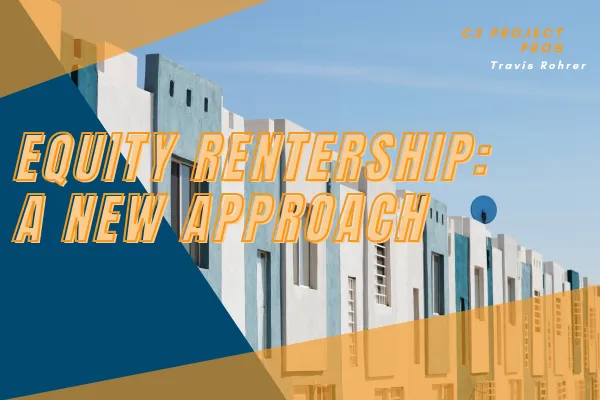
BLOG
STAY ON TOP OF CONTRACTOR TRENDS

Equity Rentership a New Approach
Affordable housing for the nation’s lowest-income families and individuals remains deeply inadequate. The shortage of seven million rental homes affordable and available to extremely low-income households is a nationwide problem. The shortage inflicts substantial harm on the lowest-income households, people who lack the foundation of a stable, secure home suffer from worse health, poorer educational advancement, and less economic mobility. The shortage at the lowest end of the market leads to cumulative shortages of affordable and available rental housing for higher-income households as well. The private market cannot and will not, on its own, build and operate homes extremely low-income families can afford. We need a sustained public commitment to ensure the lowest-income households in America have decent and affordable homes.
The lowest-income families are often forced to make impossible choices between shelter and food, healthcare, education, and other basic needs. This deprivation is severe, predictable, and avoidable; not addressing it is a failure of will and an injustice. Access to a stable, decent, affordable, and accessible home is essential to virtually every area of a person’s life. Housing is directly connected to better health outcomes, employment prospects, economic opportunities and for keeping people out of the criminal justice system.
Finding a path to equity in housing is the quickest way to break the poverty cycle for low income families. There are four ways that ownership can break the cycle.
Homeownership is one of the most effective and reliable ways to build wealth for two reasons: increased equity and price appreciation. Monthly payments are in a sense a forced sales tool. Without ownership of your housing dollars, rent is spent every month benefiting the property owner.
Homeowners typically spend less on housing costs. US Census data shows that for those that make less than $50,000 a year, 40% of those spend more than half of their income on housing. In contrast, banks require that that ratio be no greater than 30% resulting in lower monthly payments. This opens up the possibility of savings for education, health, and retirement.
Housing stability can help your children's education. There are studies that link stable housing with improved educational outcomes for children. Changing schools as a result of chasing affordable housing results in reduced reading, math and social skills.
Affordable housing enhances economic growth by attracting workers and local businesses.
A great opportunity exists for investors to take advantage of the current market conditions residing in the multifamily industry. The condition I am referring to is failed syndications. Record low interest rates and the popularity of syndicated investments have seen a big shift. Groups that were relying on those low rates on floating bridge loans have found themselves in a bit of a barney. Properties are using up their Capex budgets on interest payments resulting in properties not renovated or worse yet, vacant due to unfinished renovations. Banks are reviewing their loans and calling the note and/or taking the property back altogether.
The plan would be to find distressed properties and bring them back on line quickly and with a different management/ownership structure. The new structure would be an equity rentership structure or co-op. A cooperative, or co-op, is a type of organization or business structure that is owned and operated by its members for their mutual benefit. Cooperative principles are guided by values such as self-help, self-responsibility, democracy, equality, and solidarity.
In a housing cooperative, residents collectively own and manage the property. Instead of owning individual units, members own shares in the cooperative corporation, which in turn owns the entire property. Each member has the right to occupy a specific unit, and decisions regarding the property are typically made on a democratic basis.
It's important to note that the specific rules and structures of housing cooperatives can vary. Some co-ops may have more stringent membership requirements, while others may be more flexible. Additionally, the legal and regulatory environment for cooperatives can differ depending on the jurisdiction.
Investing in a housing cooperative is different from traditional real estate investments because investors don't typically own individual units; instead, they become shareholders in the cooperative. The returns and financial benefits for investors in housing cooperatives may vary based on the cooperative's financial structure and location. The main theme to this type of investing is to be prepared for a longer hold than the typical syndication of 3-5.
Distressed properties are those that are both physically and economically vacant. We have seen several properties that are 50% complete in renovation but have proof of concept in their approach as the physical occupancy of the renovated units match the occupancy rate of the area. Each property would have its own plan and approach. From an experienced contractor that was in the hospitality space, turning 15-20 units every 2.5-3 weeks is not only doable, it is preferred over the 1-2 off. This system is easily trainable and repeatable. This would bring down units online quickly and have each location covering debt within a couple months.
Investing in affordable housing solutions for those most in need is not only prudent and generous, it is good for the families, the communities and can have a big impact on the cycle of poverty.
To grow a community everyone can afford. People who work in our community should be able to live in our community.
Foster a healthy mix of housing types, sizes and prices, affordable at the wages of the jobs nearby. Through a variety of strategies and motivations the private, public, and nonprofit sectors create housing for our economically diverse community.
Economically diverse neighborhoods which reflect our economically diverse community. By encouraging a mix of housing prices within neighborhoods, and diverse neighbors sharing fences, we strengthen our community.
Land that is appreciated, conserved, productive, and affordable in perpetuity. A pervasive land ethic de-emphasizing a property’s speculative value. Compact urban neighborhoods with easy access to jobs and transportation choices. Using incentives and best practices to grow a livable, environmentally-sound, and compact community.
A citizenry involved in and shaping its community. A community so promising our neighbors feel invested in its future.
A generous and thankful community. A community where people will take care of each other when things fall apart.
